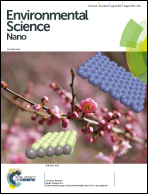Residual weakly bound ligands influence biological compatibility of mixed ligand shell, thiol-stabilized gold nanoparticles†
Abstract
Mixed ligand shells are frequently employed to impart multiple and new functions to inorganic nanoparticles. Mixtures of ligands also result from incomplete or partial ligand exchange reactions wherein one that is more tightly bound replaces a weakly bound ligand. Little is known about how the ligand compositions in mixed shell nanoparticles influence biological activity. Further, the impact of residual weakly bound ligands is not understood. To examine the biological impacts due to weakly bound ligands within a mixed ligand shell, a series of six types of gold nanoparticles (AuNPs) were synthesized that have the same core size and possess ligand shells that are predominately either 2-mercaptoethanesulfonate (MES) or N,N,N-trimethylammoniumethanethiol (TMAT), but contain varying (small) amounts of residual triphenylphosphine (TPP). Each member of the series was carefully examined to determine the core size (by small-angle X-ray scattering and transmission electron microscopy) and ligand shell composition (by 1H NMR spectroscopy and X-ray photoelectron spectroscopy). The influence of the residual, weakly bound TPP ligands upon the biological activity of the nanoparticles (NPs) was evaluated in zebrafish embryos and subsequently in human keratinocyte cells. In the embryos, the presence of residual TPP led to increased cell death that is linked to increased oxidative stress. Control experiments suggest that these effects are not the result of free ligand. Exposure of the keratinocyte cells to the TMAT-containing nanoparticles demonstrated similar results in that residual TPP decreased cell viability, likely through increased ROS generation. The results of these studies suggest that the use of strongly bound ligands that passivate the surface of the inorganic core can prevent ROS and, therefore, yield nanoparticles with reduced biological effects.



 Please wait while we load your content...
Please wait while we load your content...